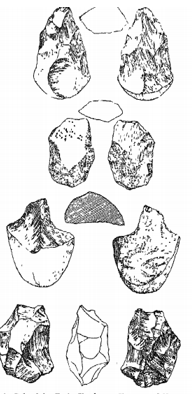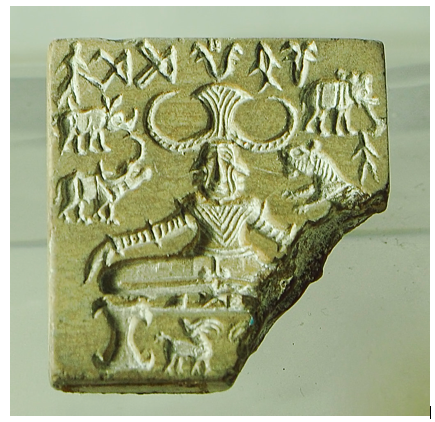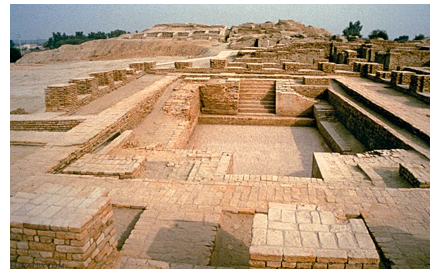History - Prehistoric Period
Day 1: Pre-historical period (Stone Age), Proto-historical period (Bronze Age)
Stone Age
- The Old Stone Age or the Palaeolithic culture of India developed in the Pleistocene period or the Ice Age which is a geological period.
- The Pleistocene period comes immediately before the geological period called Holocene or recent period, in which we live and which began about 10,000 years ago.
- In India the first human occupation, as suggested by stone tools, is not earlier than the Middle Pleistocene, which perhaps began about 500,000 years ago.
- In the Pleistocene period Ice sheets covered a great portion of the earth's surface, particularly in the higher altitudes and their peripheries.
Phases in the Palaeolithic Age
- The Old Stone or the Palaeolithic Age in India is divided into three phases according to the nature of the stone tools used by the people and also according to the nature of change in the climate. The first phase is called Early or Lower Palaeolithic, the second, Middle Palaeolithic, and the third, Upper Palaeolithic. The Lower Palaeolithic or the Early Old Stone Age covers the greater part of the Ice Age. Its characteristic feature is the use of hand-axes and cleavers. The axes found in India are more or less similar to those of Western Asia, Europe and Africa. Stone tools were used mainly for chopping. The Early Old Stone Age sites arc found in the valley of river Soan in Punjab, now in Pakistan. Lower Palaeolithic tools have also been found in the Belan valley in Mirzapur, district in Uttar Pradesh.
- The Middle Old Stone Age or Middle Palaeolithic industries are all based upon flakes. These flakes are found in different parts of India and show regional variations. The principal tools are varieties of scrapers made of flakes. We also find a large number of borers and blade-like tools The Middle Old Stone Age Sites in India are found in the Soan Valley.
- The Upper Palaeolithic phase was less humid. It coincided with the last phase of the Ice Age when climate became, comparatively warm Caves and rock shelters for use by human beings in the Upper Palaeolithic phase have been discovered at Bhimbetka, 40 kms south of Bhopal Hand-axes and cleavers, blades, scrapers and a few bruins have been found there. An Upper Palaeolithic' assemblage, characterised by massive flakes, blades, burins and scrapers has also been found in the upper levels of the Gujarat dunes.

The Late Stone Age
- The Upper Palaeolithic Age came to an end with the end of the Ice Age around 8000 B C , and the climate became warm and dry.
- From 8000 B.C. began an intermediate stage m Stone Age culture, which is called the Mesolithic Age. It intervened as a transitional phase between the Palaeolithic Age and the Neolithic or New Stone Age, and is also called the Late Stone Age. In the case of India it started about 8000 B C. and continued up to about 4090 B C. The characteristic tools of the Late Stone Age are microliths.
- The Late Stone Age sites are found in good numbers m Chotanagpur, central India, and also south of the river Krishna.
The New Stone Age
- The New Stone Age began much earlier, in 7000 B,C., Neolithic settlements in the Indian sub-continent are not older than 6000 B.C. Some settlements found in south India and eastern India is as late as 1000 B.C.
- The people of this age used tools and implements or polished stone. They particularly used stone axes, which have been found in large numbers throughout the greater part of the country.
- This cutting tool was put to various uses by the people, and in ancient legends Parasurama became an important axe wielding hero. Based on the types of axes used by Neolithic settlers, we notice three important areas of Neolithic settlements. One area is to be found in the north in the valley of Kashmir at a place, called Burzahom at a distance of about 20 km from Srinagar.
- The Neolithic people lived there on a plateau in pits, and probably had hunting and fishing economy. They did not seem to have been acquainted with agriculture or domestication of animals. They used not only polished tools· of stone, but what is more interesting, they used numerous tools and 'weapons made of bone.
- The, only other place which has yielded considerable bone implements in India is Chirand which is 40 km west ,of Patna on the northern side of the Ganga . These bone implements have been found in a late Neolithic setup in an area with about 100 cm rainfall. The settlement became possible because of the open land available on account of the joining together of four rivers, Ganga, Son, Gandak and Ghaghra at this' place .The people of Burzahom used coarse grey pottery.
- It is interesting' that the Burzahom domestic dogs were buried with their masters in their graves: pit dwelling and the placing of domestic dogs in the graves of the masters do not seem to be the practice with Neolithic people in any other part of India.
- Some of the important Neolithic sites or those with Neolithic layers that have been excavated include Maskl, Brahmagiri, HaUur, Kodekal, Sallganakallu, T. Narsipur and Takkalakota in Karnataka, and Paiyampalh in Tamil Nadu. Piklihal and Utnur are important Neolithic sites in Andhra Pradesh.
- The later Neolithic settlers were agriculturists, who lived in circular or rectangular houses made of mud and reed. It is held that the primitive people living in circular houses owned property in common. In any case these Neolithic people led a settled life. They produced ragi and horsegram (kulathi). Their polished tools also included microlith blades.
- Since in the Neolithic phase several settlements came to be acquainted with the cultivation of cereals and the domestication of anima.ls, they needed pots ill which they could store their food grain and milk. They further needed pots for cooking and eating. Hence hand-made pottery is found in the early stage. Later they used foot wheels to turn up pots. Neolithic celts have also been found In the Orissa hill areas and it 1s likely that rice Cultivation and small-scale settlements began 10 this part of the country quite early.
- The people of the Stone Age suffered from one great limitation. Since they had to depend entirely on tools and weapons made of stone, they could not found settlements far away from the hilly areas. They could settle down only in the hilly river valleys. Further, even with great effort they could not produce more than what they needed for their bare subsistence.
INDUS VALLEY CIVILIZATION
- The Indus Valley in the Indian sub-continent was one of the early centres where man settled down and progressed to-lead a highly civilized life. Geographical factors like climate, fertility of the soil and the physical features greatly contributed to the progress and development of man there. This civilization, familiar to the world as the Indus Valley Civilization or the Harappan Culture, flourished about 5000 years ago.
- Initially historians called this civilization the Indus Valley Civilization. But of late historians prefer to call it the Harappan Culture. Most of the sites of this civilization discovered earlier were in the Indus Valley only. The sites included Harappa and Mohenjo-Daro. But in recent years, a large number of sites belonging to this civilization have been found in areas far away from the Indus Valley. For example, the sites at Kalibangan and Lothal revealed features similar to those of the Indus Valley. Therefore, historians feel that the name Indus Valley Civilization is not appropriate. Further, most of these sites have many similarities to the urbanised culture of the people of Harappa, the first site of this culture to be discovered in 1921. Therefore, this civilization is called the Harappan Culture.
Extent of the Harappan Culture
- It covered parts of Punjab, Haryana, Sindh, Baluchistan, Gujarat, Rajasthan and the fringes of western Uttar Pradesh. It extended 'from Jammu in the north to the Narmada estuary in the south and from the Makran coast of Baluchistan in the west to Merrut in the north-east. It covered an area of about 1,299,600 square kilometres. It covered a much larger area than the ancient Egyptian or Mesopotamian culture did.
Geographical Factors which helped the growth of this Civilization
- The Indus seals are found to have figures of a variety of plants and animals which can exist only in moderately wet, conditions. Therefore, it is assumed that the climatic conditions were quite moderate. Added to this, the vast plains along the Indus were very fertile. The floods deposited rich alluvial soil on these plains every year and irrigated the lands. These geographical factors i greatly helped the prosperity of Indus habitations.
Town Planning
- One of the most outstanding features of the Indus cities was that they were well planned. The excavations at Harappa and Mohenjo-Daro have shown a lot of evidence of this. The city had two parts, i.e., the citadel and the outer city.
- The citadel was built on an elevated area. The outer city was at a lower level. The roads were wide and straight cutting each other at right angles.
- They also had a perfect drainage system. Each house had a well constructed sink from which water flowed into the underground drains.
- These drains along the road were covered by loose bricks. Houses were of different types, small and large. Burnt bricks were extensively' used.
- Houses were also provided with wells and bathrooms.
- The other important structures found in the Indus cities include the Great Bath and pillared hall at Mohenjo-Daro, the dockyard at Lothal and the granary at Harappa. These structures stand testimony to the architectural skills of the Indus people.
Social Life
- Social classes: The fact that there were different types of houses indicates that there were different social classes. Trading being the major activity, the merchants seem to have formed the upper class. The artisans and farmers might be the common people.
- Dress: No definite account is available about the type of dresses used by the Indus people. The discovery of a number of spindies suggests the use of cotton and woollen fabrics. The bronze statues too give some information about the dress of the people. The women wore a skirt and an upper garment. Men wore a band of cloth around their loin and a loose garment over their shoulders.
- Ornaments: A large number of ornaments like necklaces, armlets, finger-rhgs, bangles, etc., have been found from these sites. These were made of gold, silver, iv6ry and precious stones. Some of the ornaments were also made of shells, bones, copper and bronze. It appears that both men and women wore ornaments. The statues of a dancing girl and a bearded man suggest that these people used hair pins and knew different hair styles.
- Recreation and amusements: The people of Harappa seem to have had a great liking for dance and music. They were also familiar with indoor games like dice. A large number of terracotta toys were found in Mohenjodaro.
Economic Conditions
- Agriculture: Agriculture was the main occupation of the Indus people. They grew I wheat, barley, peas and in some places rice. They not only produced enough for themselves but also for trade. They did not irrigate their lands by canals. The annual flood provided enough moisture to grow crops. Fields were ploughed using a wooden ploughshare.
- Domestication of animals: On the basis of the Indus seals, it can be said that a large number of animals including goats, buffaloes, oxen, elephants, dogs and camels were domesticated. But the Harappans seem not to have been familiar with the horse.
- Crafts: The Harappan people were good craftsmen. Bronze work had reached a degree of perfection. Brick-making and masonry were other important occupations. Pottery made on potter's wheel was decorated with different designs and painted red and black. Spinning and weaving too were a common craft.
- Trade: The urban culture and highly specialised manufacturing activity suggest that the Harappan cities had a flourishing trade. There was flourishing internal trade between the cities. The river Indus served as the high waterway through which most of this trade was carried out.
Religious Practices
- We do not have any specific information about the religious beliefs of the Harappan people. However, on the basis of archaeological finds we can come to certain conclusions.
- No temples have been found from any of the Harappan sites. Figurines resembling a female deity have been found.
- They suggest worship of Mother Goddess. A seal with animals figure sitting in a logic posture with a trident-like headgear, surrounded by animals, has been found.
- This has a lot of similarities with Shiva. From this it is figured that the Harappans might be worshipping Shiva.

Decline
- The Harappan Culture lasted for about a thousand years and collapsed by about 1800 BC.
- This coincides with the advent of the Aryans in India.
- The exact reason for the decline of this civilization is not known.
- These cities might have got destroyed in conflicts with the Aryans.
- But the generally accepted view among historians is that a gradual change in climatic conditions rendered the region inhospitable and caused its decline.
- Some people also believe that natural calamities like floods or earthquakes might have caused its destruction.

No comments:
Post a Comment